 | |
| Other names | Andalusian-Friesian |
|---|---|
| Standard | BZVKS (in German) |
The Warlander is a horse of Baroque type, produced by crossing Friesian horses with horses of a purebred registered Iberian horse breed such as the Andalusian, Lusitano, or Menorquina. [1]
 | |
| Other names | Andalusian-Friesian |
|---|---|
| Standard | BZVKS (in German) |
The Warlander is a horse of Baroque type, produced by crossing Friesian horses with horses of a purebred registered Iberian horse breed such as the Andalusian, Lusitano, or Menorquina. [1]
For much of the sixteenth century, the Low Countries were under Spanish rule; Iberian horses brought there from Spain may have influenced the development of local horse types including the Friesian. [2] : 89
The Classical Sporthorse Stud in Western Australia named the breed after their association with veterinarian Warwick Vale in the late twentieth century. [3] [4]

The Warlander is not listed by the Universal Equine Life Number foundation. [5] A bred standard is published by the Bayerischer Zuchtverband für Kleinpferde und Spezialpferderassen, which has a UELN number. [6] [7] [ dubious ]
Significant debate exists over whether a Warlander will only obtain genetic benefit if it is an F1 hybrid. [8] A crossbred animal is likely to enjoy hybrid vigor and therefore have genetic gains over both of its parents. [8] However, there is uncertainty over whether an F2 horse - produced by a Warlander-Warlander, Warlander-Andalusian, or Warlander-Friesian pairing - would be likely to suffer from genetic atavism. [8] The statistically tiny number of F2 and subsequent generation Warlander horses bred internationally has meant empirical resolution of this question has not yet been possible. [8] [ dubious ] [9] The Warlander Studbook Society acknowledges that the following genetic defects are known to come from the base breeds of the Warlander and WSS breeders must notify the society if any horses show the following - Cryptorchidism, Monorchidism, Dwarfism, Fallen Crest, Water head/crown head foals (hydrocephalus) and Mesocolic Rente. [10]
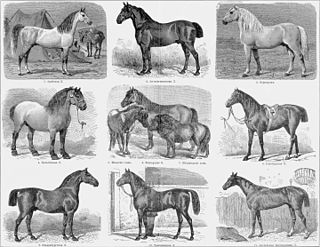
A horse breed is a selectively bred population of domesticated horses, often with pedigrees recorded in a breed registry. However, the term is sometimes used in a broader sense to define landrace animals of a common phenotype located within a limited geographic region, or even feral "breeds" that are naturally selected. Depending on definition, hundreds of "breeds" exist today, developed for many different uses. Horse breeds are loosely divided into three categories based on general temperament: spirited "hot bloods" with speed and endurance; "cold bloods," such as draft horses and some ponies, suitable for slow, heavy work; and "warmbloods," developed from crosses between hot bloods and cold bloods, often focusing on creating breeds for specific riding purposes, particularly in Europe.

The Groninger or Groningen is a Dutch horse breed developed for light draft and agricultural work. It is closely related to heavy warmblood breeds like the East Friesian and Alt-Oldenburger. The breed was nearly lost in the mid-20th century because a significant number of mares were used for crossbreeding to create the Dutch Warmblood, leaving few purebreds.

The Friesian is a horse breed originating in Friesland, in the Netherlands. Although the conformation of the breed resembles that of a light draught horse, Friesians are graceful and nimble for their size. It is believed that during the Middle Ages, ancestors of Friesian horses were in great demand as war horses throughout continental Europe. Through the Early Middle Ages and High Middle Ages, their size enabled them to carry a knight in armour. In the Late Middle Ages, heavier, draught type animals were needed. Though the breed nearly became extinct on more than one occasion, the modern day Friesian horse is growing in numbers and popularity, used both in harness and under saddle. Most recently, the breed is being introduced to the field of dressage, causing the decline of the draught-type with its sturdy legs and back.
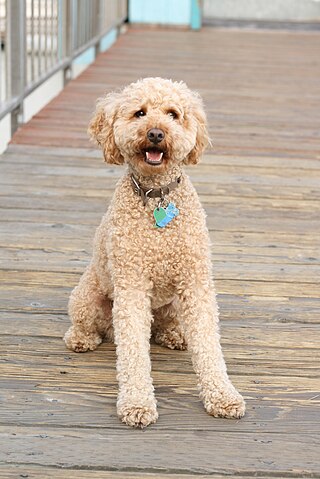
A crossbreed is an organism with purebred parents of two different breeds, varieties, or populations. Crossbreeding, sometimes called "designer crossbreeding", is the process of breeding such an organism. While crossbreeding is used to maintain health and viability of organisms, irresponsible crossbreeding can also produce organisms of inferior quality or dilute a purebred gene pool to the point of extinction of a given breed of organism.

The Lusitano, also known as the Pure Blood Lusitano or PSL, is a Portuguese horse breed. Horses were known to be present on the Iberian Peninsula as far back as 20,000 BC, and by 800 BC the region was renowned for its war horses. The fame of the horses from Lusitania goes back to the Roman Age, which attributed its speed to the influence of the West wind, who was considered capable of fertilizing the mares. When the Muslims invaded Iberia in 711 AD, they brought Arabian horses with them that were crossed with the native horses, developing a horse that became useful for war, dressage and bull fighting. The Portuguese horse was named the Lusitano, after the word Lusitania, the ancient Roman name for the region that modern Portugal occupies. There are four main breed lineages within the breed today, and characteristics differ slightly between each line.

The Sorraia is a rare breed of horse indigenous to the portion of the Iberian peninsula, in the Sorraia River basin, in Portugal. The Sorraia is known for its primitive features, including a convex profile and dun coloring with primitive markings. Concerning its origins, a theory has been advanced by some authors that the Sorraia is a descendant of primitive horses belonging to the naturally occurring wild fauna of Southern Iberia. Studies are currently ongoing to discover the relationship between the Sorraia and various wild horse types, as well as its relationship with other breeds from the Iberian Peninsula and Northern Africa.

The Boulonnais, also known as the "White Marble Horse", is a draft horse breed. It is known for its large but elegant appearance and is usually gray, although chestnut and black are also allowed by the French breed registry. Originally there were several sub-types, but they were crossbred until only one is seen today. The breed's origins trace to a period before the Crusades and, during the 17th century, Spanish Barb, Arabian, and Andalusian blood were added to create the modern type.

The term baroque horse describes a group of horse breeds, usually descended from and retaining the distinctive characteristics of a particular type of horse that rose to prominence in Europe during the Baroque era, after significant development throughout the Middle Ages. It describes the type of agile but strong-bodied descendants of horses in the Middle Ages such as the destrier. Specific ancestors of this type include the Neapolitan horse, and the Iberian horse of Barb ancestry known in the Middle Ages as the Spanish Jennet. They are characterized by powerful hindquarters, a muscular, arched neck, a straight or slightly convex profile, and usually a full, thick mane and tail. These horses are particularly well suited for the haute ecole discipline of classical dressage.

The Bavarian Warmblood is a horse breed of southern Germany that developed from an older Bavarian heavy warmblood breed called the Rottaler. Since mechanization in the mid-20th century, the Bavarian Regional Horse Breeders' Society has concentrated on producing a riding horse for the Olympic disciplines and recreational riding based on other European warmblood bloodlines.

The Friesian Sporthorse is a Friesian crossbred of sport horse type. The ideal Friesian Sporthorse is specifically bred to excel in FEI-recognized sport horse disciplines. Thus, "sporthorse" refers to the phenotype, breeding, and intended use of these horses. The term "Friesian Sport Horse" is a generic term to describe any Friesian-cross horse.

The heavy warmbloods are a group of horse breeds primarily from continental Europe. The title includes the Ostfriesen and Alt-Oldenburger ("Old-Oldenburger"), Groningen, and similar horses from Silesia, Saxony-Thuringia, and Bavaria. Breeds like the Hungarian Nonius, Kladruber, and Cleveland Bay are also often classed as "heavy warmbloods." They are the ancestors of the modern warmbloods, and are typically bred by preservation groups to fit the pre-World War I model of the all-purpose utility horse. Unlike the registries of the sport horses that followed them, many heavy warmblood registries maintain closed or partly closed studbooks. However, external evaluation and performance testing of the breeding stock is still a key element in these registries. Many of the heavy warmbloods are selected primarily for family-friendly temperaments.

The Alt-Oldenburger and Ostfriesen are representatives of a group of horse breeds primarily from continental Europe called heavy warmbloods. The breed has two names because the same horse was bred in two regions in the most north-western part of Germany: East Frisia and the former grand duchy of Oldenburg. The name "Alt-Oldenburger" - alt meaning "old" - simply distinguishes this horse from its descendant, the modern Oldenburg, which is bred for sport.
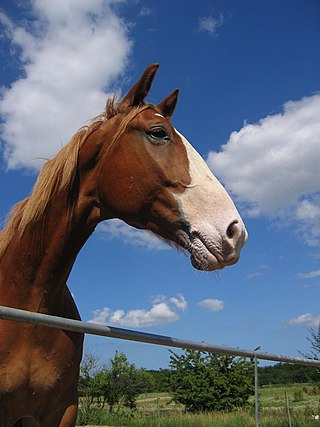
The Frederiksborger is Denmark's oldest horse breed. They were tremendously popular throughout the Renaissance and Baroque periods and were considered luxury items. Today, the breed is rare, but has a loyal following. Stallions and mares undergo studbook inspections before being allowed to breed. They are most often chestnut with white markings.
Foundation stock or foundation bloodstock refers to animals that are the progenitors, or foundation, of a breed or of a given bloodline within such. Many modern breeds can be traced to specific, named foundation animals, but a group of animals may be referred to collectively as foundation bloodstock when one distinct population provides part of the underlying genetic base for a new distinct population.
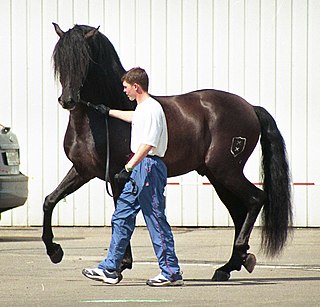
The Andalusian, also known as the Pure Spanish Horse or PRE, is a horse breed from the Iberian Peninsula, where its ancestors have lived for thousands of years. The Andalusian has been recognized as a distinct breed since the 15th century, and its conformation has changed very little over the centuries. Throughout its history, it has been known for its prowess as a war horse, and was prized by the nobility. The breed was used as a tool of diplomacy by the Spanish government, and kings across Europe rode and owned Spanish horses. During the 19th century, warfare, disease and crossbreeding reduced herd numbers dramatically, and despite some recovery in the late 19th century, the trend continued into the early 20th century. Exports of Andalusians from Spain were restricted until the 1960s, but the breed has since spread throughout the world, despite their low population. In 2010, there were more than 185,000 registered Andalusians worldwide.
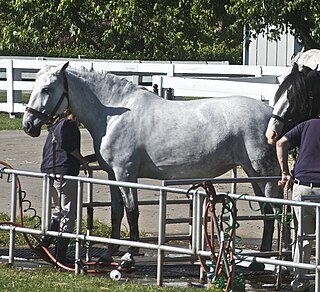
The Spanish Norman is an American horse of warmblood type, a crossbreed of the Andalusian and Percheron. In 1991, a registry was created in Connecticut in the United States to maintain records of the breed. The Spanish-Norman is bred primarily as a sport horse.

The Senner or Senne is a critically-endangered German breed of riding horse. It is believed to be the oldest saddle-horse breed in Germany, and is documented at least as far back as 1160. It is named for the Senne, a natural region of dunes and moorland in Nordrhein-Westfalen, in western Germany, and lived in feral herds there and in the Teutoburger Forest to the east.
The Baroque Pinto is a Dutch horse breed of Baroque type founded in the 1950s and 1960s, using the Friesian horse, Dutch Warmblood (KWPN), German Warmblood, and other European warmblood breeds for its foundation stock. Some consider it to be a type of Friesian cross or Friesian Sporthorse, while others consider it to be its own breed.

The Carthusian' horse, sometimes known as Cartujano in Spanish, is a bloodline group within the Purebred Spanish horse (PRE). The earliest lineages were tracked by 1476, leading to claims its breed registry is one of the oldest in the world. The Carthusian lineage descends from a gray stallion named Esclavo, who became the property of the Carthusian monks of Andalusia. The monks made a success of this breeding, which became famous throughout Europe in the 18th century. The Carthusian horse is morphologically distinguished from other PRE lines by its lighter body and straighter head profile, with the possible presence of bony protuberances. The Carthusian coat is usually gray. The Carthusian is used as a dressage horse and is well suited to combined driving. Carthusian breeding is concentrated in its birthplace, Andalusia, around Jerez de la Frontera, Badajoz and Cordoba.